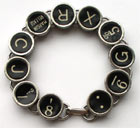 A few weeks ago I had a little flood in my basement. The sump pump backed up and left about 3-4 inches of water all around. The overall damage wasn’t so bad, but I’d left my nascent collection of manual typewriters on the floor (in preparation for moving them to my studio) and thus they were ruined. Oh, I know they could have dried out and all, but the cases were truly destroyed by the water. It makes me sad to lose them, especially my 1932 Royal.
A few weeks ago I had a little flood in my basement. The sump pump backed up and left about 3-4 inches of water all around. The overall damage wasn’t so bad, but I’d left my nascent collection of manual typewriters on the floor (in preparation for moving them to my studio) and thus they were ruined. Oh, I know they could have dried out and all, but the cases were truly destroyed by the water. It makes me sad to lose them, especially my 1932 Royal.
So here is a eulogy, a little ode I wrote a long time ago to that machine and small little writing machines in general…
Oh dull crimson shell! From this once gleaming hull, come only scents of aged oil. Unrestored, this typewriter in the wild. Small and light, gold letters faded, only chrome trim shines. An action that's slack catches a casual typist unaware. How easy it is to slip into fluid motion. A final memory follows, how forgotten the space beyond...
My fascination with this machine is not limited to its visual appearance. True enough, I sit at the machine and picture myself in a small room, equipped with a desk and single chair, a window looking out onto an alley. There’s a shot of whiskey on the table, with a neighborly ashtray of leaded glass cradling the smoldering remains of a stubby cigarette. There may or may not be an overhead fan, if not there is a bare lightbulb switched off. If I’m not feeling up to such muscular pursuits, I trade Dashiell Hammett for Virginia Woolf. I sit in an English country manor, looking out into a garden bursting with perennials and apidae.
 I’m not wanting for a list of locales. I’ve written in so many different places as to have forgotten all but the most common and the exceptional. However, if speed of production combined with prodigious volume could be classified as quality {though I see no reason why it should as this combination has rarely been mentioned in a positive light with the exception of dramatized presentations of the artistic life and journals of industrial efficiency}, some of my best work has come during air travel.
I’m not wanting for a list of locales. I’ve written in so many different places as to have forgotten all but the most common and the exceptional. However, if speed of production combined with prodigious volume could be classified as quality {though I see no reason why it should as this combination has rarely been mentioned in a positive light with the exception of dramatized presentations of the artistic life and journals of industrial efficiency}, some of my best work has come during air travel.
On an airplane, one is generally confined to a single seat for the journey’s duration. All thought is crammed into twenty-eight inch column, enclosed within a steel canister soaring far above the diversions of the soil. In such cramped and pressurized climates, I find my thoughts funneled, gaining a weird density coupled with urgency. When abroad, hotel rooms inspire the same feeling. A solitary room, where interruption is so unlikely, produces a slight panic, inspires a sort of bliss, unless one fails to produce and then it is hell.
I could go on like this for some time, extolling the virtues and defects of so many libraries and beach houses and park benches and cafes. I might add that I’ve never had much success on a train, as the rails inspire me to read or engage in conversation, with the latter often causing me to retreat to the former. This sort of writing I could do, for pages and pages, but perhaps I might take a moment to explore a portrait as opposed to the landscape, narrow the lens and see the writer and their instrument in the plain light.
There is a figure, seated or standing, with an instrument and a medium. We may place a pen between the fingers of our writer. We may allow their fingers to tread lightly on the keys of a bright metallic laptop. Regardless of the configuration, it is the space we take interest in, the zone where thought meets record.
The typewriter provides the perfect exhibit for the study this writing space. The paper is wound about the cylinder, a lever shuttles the carriage and advances the paper, and line by line prose takes form. A writer’s natural focus falls to the neatly delineated space between the card fingers {the small metal wings on either side of the spot where the letters strike the page} and the card holder bail {the spring or hinge-bound arm that keeps the paper tight against the cylinder}. Imagine the intimacy of this one-by-eleven inch room and one might derive some insight into why writers are so attached to their machines.
Through the years, I’ve owned a variety of writing machines. And though the heft and violent machinations of the larger breeds impresses most, and sometimes fills us with a giddy sense of power as they hummed or banged or merely sat and looked sullen, I admit an inescapable affinity for the smallest of the line. Perhaps it is my manner of typing? I’m a two-fingered bandit, pecking away with sturdy index fingers, hammering sentences too loose with run-ons and loopy prose with frightening accuracy and determination. Such is the fury of my pecking and pricking, that bystanders have mused on the possibility that my fingers could penetrate blocks of wood if given quarter.
With such technique, it seems natural that I would be drawn to machines with the shortest span between keys, though I suspect that this is only part of the attraction. A writer easily finds space inside a room and perhaps more dubiously in a writing implement, but what about a style? Is there space within a style? Regardless of technique, writers certainly seem to crave their own styles, appropriating others and casting them aside when they become stifling. Great writers are often called great because of the variety of styles to which they lend their efforts or to the styles they create.
As legend has it, Tom Wolfe created the style of New Journalism. Now told some forty years past, the tale is that Mr. Wolfe was on assignment to write an article about the custom car culture in southern California, and as the deadline loomed, he found himself at odds with the piece. He felt constrained by style, and instead of working through it he sent the editor a long letter, which with salutation removed was printed in full without correction or adjustment.
 Whether one accepts this bit of folklore or not hardly matters. A discourse on the School of New Journalism is kind of irrelevant here, I admit. However, I admire Mr. Wolfe’s sense of style. And since I am primarily interested in space, I’m left to wonder if Mr. Wolfe escaped into a new and larger field by breaking the traditional mold or if he somehow collapsed himself into a more private space by sharing his personal feeling and impressions. The world builders of literary thought are likely to assume the former, but I think that in practice Wolfe and others like Hunter S. Thompson – or even Norman Mailer – made their work of a finer grain.
Whether one accepts this bit of folklore or not hardly matters. A discourse on the School of New Journalism is kind of irrelevant here, I admit. However, I admire Mr. Wolfe’s sense of style. And since I am primarily interested in space, I’m left to wonder if Mr. Wolfe escaped into a new and larger field by breaking the traditional mold or if he somehow collapsed himself into a more private space by sharing his personal feeling and impressions. The world builders of literary thought are likely to assume the former, but I think that in practice Wolfe and others like Hunter S. Thompson – or even Norman Mailer – made their work of a finer grain.
So fine a grain, some might argue, as to be unreadable – rather like this ode.
Such thoughts answer nothing of course, only prompting more questions. Let us sweep them aside for this has gone on quite long enough. Getting back to the simple observation prompted my initial investigation: we tend to write more when forced to wedge our work into a space of fixed dimensions. The physical size of the page {or page-like object, such as a text box on a web page} is the key driver. We feel impelled to peck away with veracity when the page is smaller. Kurt Vonnegut explored this concept in Hocus Pocus where the narrator writes out the story on any paper he comes across, some full sheets but on slips pulled from an unused library card catalogue and even a bits of scrap.
I have no idea if it was a successful experiment, but I liked the book.
If pressed, I might decide that intimacy is the reason for my love of small spaces. However, I suspect something more negative at work, like fear. It seems more likely that I am afraid of saying too little, of being misunderstood. I harbor fears of inadequacy, of saying the wrong thing in an inappropriate manner. I certainly fear the commonplace and the popular, most especially in being associated with either. As a result, I cram ourselves into the smallest possible space, the most secure surroundings. I flee the larger world and its expectations, retreating into esotericism.
This doesn’t explain the flinging of my work into the ether, but it might explain why Emily Dickinson kept hers locked in a trunk.

